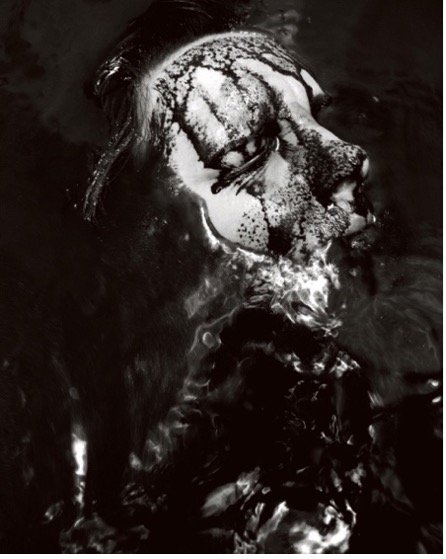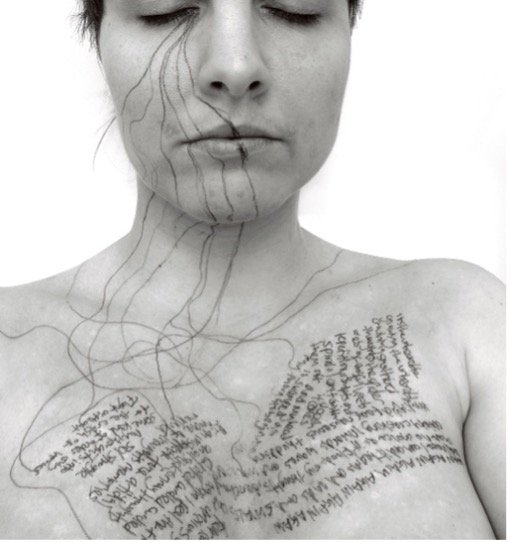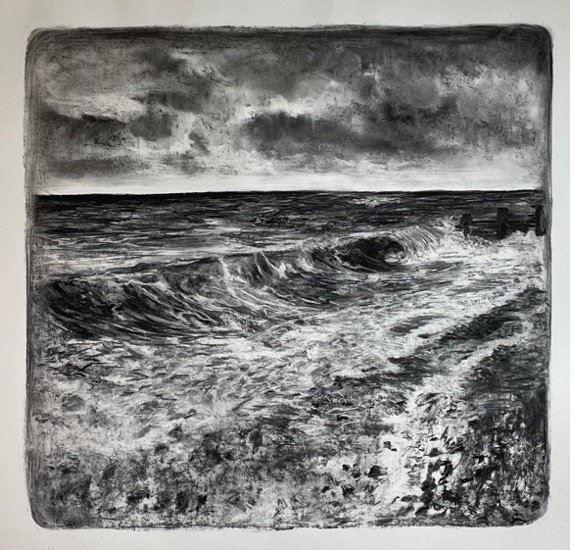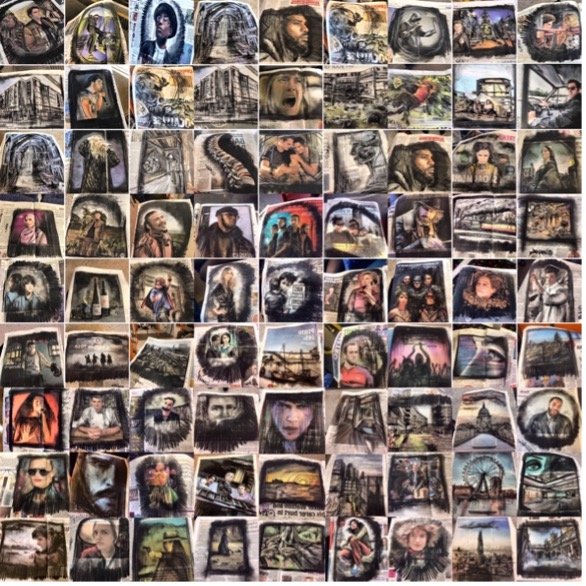Artist spotlight: Liz Atkin
Content warning: This article contains discussions of mental illness.
Liz Atkin is a visual artist and educator. Her work expresses and explores a lifelong relationship with compulsive skin picking (dermatillomania), a body-focussed repetitive behaviour and mental health condition characterised by extreme and often unconscious rubbing, touching, scratching, picking at, or digging into one’s skin. It is considered a self-soothing behaviour, occurring in moments of stress, anxiousness, or boredom.
Greeting me via Zoom on an uncharacteristically sunny January day, one of Liz’s life-sized charcoal landscapes hangs behind her in the bright afternoon glow. She explains how she unexpectedly came to her creative practice—“it’s certainly not something I ever thought I’d end up doing”. With a background in theatre, it was a master’s degree in dance that brought her uncomfortably face-to-face with the physical manifestations of repetitive skin picking in her everyday movement. Researching the condition online, she quickly discovered shared experiences of other sufferers. With this, she made “a commitment to creatively understanding the condition better, without medical support or therapy”.
Liz’s earliest works explored sections of her body affected and marked by skin picking in quite an abstract fashion. She experimented with acrylic and pastel dust, using her body as a canvas.
Image credit from left to right: Blue by Liz Atkin (Copyright), Acrylic by Liz Atkin (Copyright)
“The process of coming to terms with skin in my work was really about rethinking the places [on my body] I found the most difficult; to own them in a different way”
But the central context of skin picking remained purposefully concealed in Liz’s work, with her biography offering only “a vague description about skin”. This all changed before a solo exhibition at London’s Bethlem Gallery. “I had this moment of: do I reclaim this, and put it in the biography? You know what, I’m just going to say it,” she recounts. With this resolve she placed a deliberate focus on identity in her pieces and stronger attention on the emotional impact of skin picking.
Image credit from left to right: Curdled by Liz Atkin (Copyright), Silent Lament by Liz Atkin (Copyright)
Adoption of charcoal was another significant juncture in Liz’s evolving work. “It happened by accident . . . a friend bought me a box as a present,” she says, explaining her instinctive gravitation towards texture, a pull that is deeply interconnected with the physical nature of skin picking. Charcoal, she tells me, possesses a texturally therapeutic quality: “the smudging of it, the manipulation” offers a soothing antidote to skin picking’s deeply tactile character.
Image credit: Pouring Mountains by Liz Atkin (Copyright)
Skin picking is a disorder rooted in both the physical and psychological. Liz describes its “constant energy—there is a real rhythm to it in my body”. Sketching with charcoal refocuses this energy through “the speed, the control” and an active urgency of her hands and fingertips across the page. The human size of her charcoal landscapes underscores this creative redirection: “they are very deliberately the size of me; it is kind of my full body engagement with it”.
Liz’s creative practice has become a therapeutic tool for reimagining her skin picking. “Recovery’s quite an active word for me; you have to work at it.” Yet she speaks of gentle acceptance as an everyday practice, moving with skin picking instead of against it. Trusting in art in moments of overwhelming physical sensation has become key to this. She sees it as both conversation and collaboration, “with my head, my body, my surface: all together”.
Image credit: Whitstable in Charcoal by Liz Atkin
Image credit: Resilience by Liz Atkin
Reflecting on her practice, she speaks with a modest bewilderment and frankness in turn: “it’s come from something awful, something monstrous”. She alludes to the complex emotions of compulsive skin picking, to the “horror and guilt and awful shame” alongside a desperate need to conceal and camouflage.
Liz is well-known for her #CompulsiveCharcoal series—abstract charcoal sketches created during her journeys on London public transport to quell anxiety, and unconscious skin picking. She one day ran out of pages in her notebook—“I felt a panic attack coming . . . I made a split-second decision to draw over a discarded newspaper nearby.” Thereafter, she found herself in conversations about skin picking on the train. “That connection and dialogue happened by accident, but became really deliberate,” she notes.
Image credit: #CompulsiveCharcoal by Liz Atkin
Liz has given away over 18,000 newspaper sketches; mental health advocacy and raising awareness about skin picking are now central to her work. She expresses what finding shared connection means with an isolating and complex health condition: “the release of identifying with somebody else is beyond anything”.
Image credit: Lockdown Watercolour by Liz Atkin
Liz’s public transport encounters have gone with the COVID-19 pandemic. “I’ve lost that way to connect . . . I’ve lost drawing on newspapers . . . I’ve lost the process of journeys.” She has since moved to be closer to the coast. Liz now redirects the repetitive energy of her skin picking into everyday beach sketching, using charcoal as well as ink and watercolours. “I’m drawing repeatedly,” she explains, “the repetition hasn’t gone away, just the process of drawing is now observational.”
She has also leant more strongly into the exploration of everyday outdoor textures, creating new connections through shared photography under a #TextureHunterGatherer theme. Liz identifies these explorations as collectively bringing a changed rhythm to her life and practice. I ask how she thinks of her current work in a time of continued unpredictability. “I feel like [it’s] finding new peace, and all the drama of what’s going on is being absorbed in a different way.”
Image credit: #TextureHunterGatherer by Liz Atkin
Further information on Liz’s work, teaching and advocacy can be found on her website.
Her community outreach can be followed via Instagram and Twitter.
For help with body-focused repetitive disorders (BFRBs), contact your GP for support and advice on treatment or go to:www.bfrb.org










